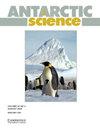从海洋沉积物物源分析揭示南极洲东部威尔克斯冰下盆地复杂的冰下地质
IF 2
4区 地球科学
Q3 ENVIRONMENTAL SCIENCES
引用次数: 1
摘要
破译威尔克斯冰下盆地地区的冰下地质对于理解固体地球冰盖演化以及评估东南极洲与以前毗邻的澳大利亚之间的地质联系具有重要意义。我们分析了来自综合海洋钻探计划远征318的U1359钻探点的海洋沉积物样本。我们的研究首次报道了内陆沉积物源区由一个复杂的基性火成岩地形和一个变质的前寒武纪冰下基底组成。辉石地球化学分析证实了拉斑岩到钙碱性玄武岩的存在。冰下地形的高等级部分包含上部角闪岩至麻粒岩相岩,与澳大利亚Terre ad本文章由计算机程序翻译,如有差异,请以英文原文为准。
Unravelling the complex sub-ice geology of the Wilkes Subglacial Basin region of East Antarctica from marine sediment provenance analyses
Abstract Deciphering the sub-ice geology in the Wilkes Subglacial Basin region is important for understanding solid earth-ice sheet evolution and for assessing geological ties between East Antarctica and formerly contiguous Australia. We analyse marine sediment samples derived from drill site U1359 of Integrated Oceanic Drilling Program Expedition 318. Our study reports for the first time that the inland sediment source area comprises a complex mafic igneous terrain and a metamorphosed Precambrian subglacial basement. Pyroxene geochemical analyses confirm the presence of tholeiitic to calc-alkaline basalts. The high-grade part of the subglacial terrain contains upper amphibolite to granulite facies rocks that are comparable to Archaean to Palaeoproterozoic rocks exposed in the Terre Adélie Craton and the formerly adjacent Gawler Craton in Australia. Chemical Th-U-total Pb isochron method (CHIME) ages extracted from a subhedral monazite grain associated with the low-grade biotite-muscovite schist rock fragment provide a unimodal age of 799 ± 13 Ma. Rare occurrences of 800 Ma age in the Terre Adélie Craton and/or George V Coast provide evidence for the presence of at least one late Neoproterozoic magmato-metamorphic event in the interior of Wilkes Land. The affinity of the unexposed geological domains of Wilkes Land, East Antarctica, with their Australian counterparts is discussed in the context of the Rodinia supercontinent.
求助全文
通过发布文献求助,成功后即可免费获取论文全文。
去求助
来源期刊

Antarctic Science
地学-地球科学综合
CiteScore
3.60
自引率
6.20%
发文量
42
审稿时长
3 months
期刊介绍:
Antarctic Science provides a truly international forum for the broad spread of studies that increasingly characterise scientific research in the Antarctic. Whilst emphasising interdisciplinary work, the journal publishes papers from environmental management to biodiversity, from volcanoes to icebergs, and from oceanography to the upper atmosphere. No other journal covers such a wide range of Antarctic scientific studies. The journal attracts papers from all countries currently undertaking Antarctic research. It publishes both review and data papers with no limits on length, two-page short notes on technical developments and recent discoveries, and book reviews. These, together with an editorial discussing broader aspects of science, provide a rich and varied mixture of items to interest researchers in all areas of science. There are no page charges, or charges for colour, to authors publishing in the Journal. One issue each year is normally devoted to a specific theme or papers from a major meeting.
 求助内容:
求助内容: 应助结果提醒方式:
应助结果提醒方式:


